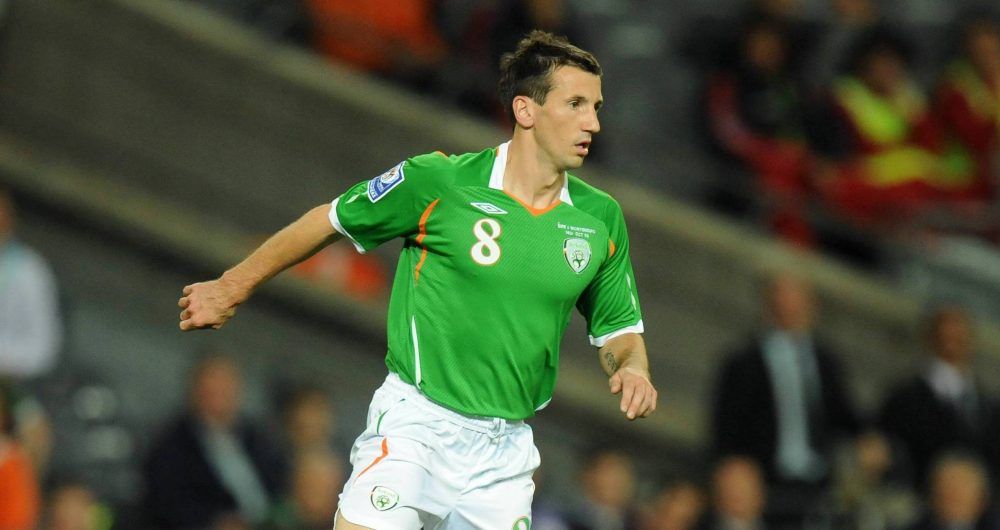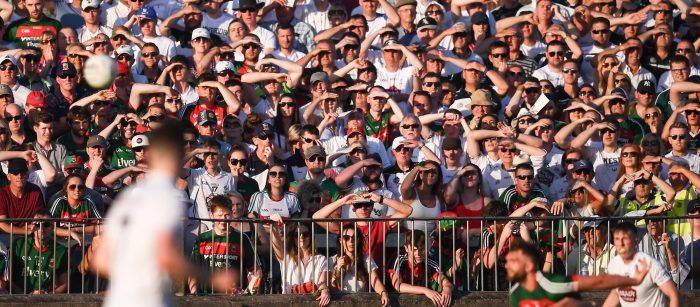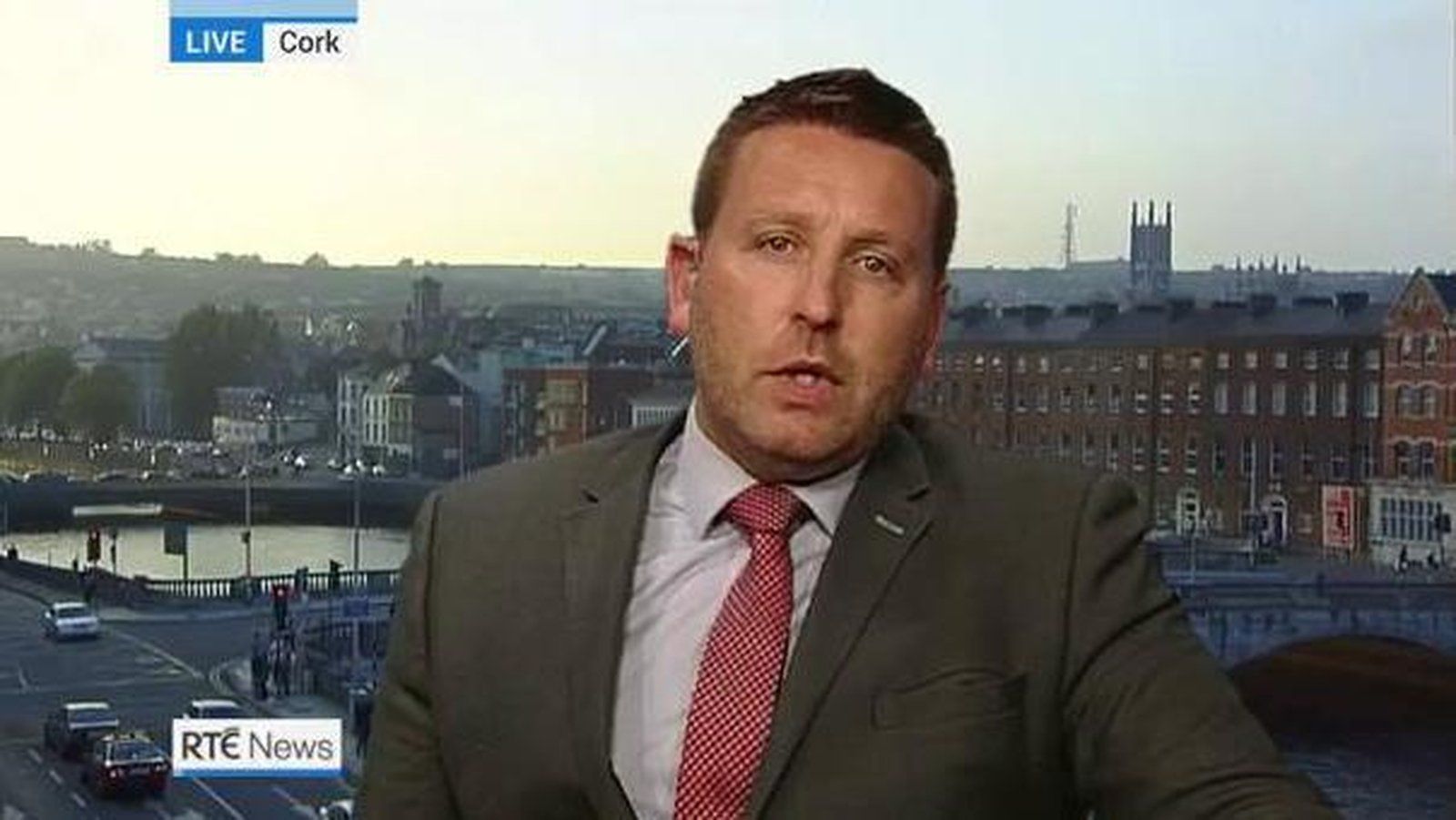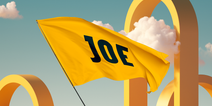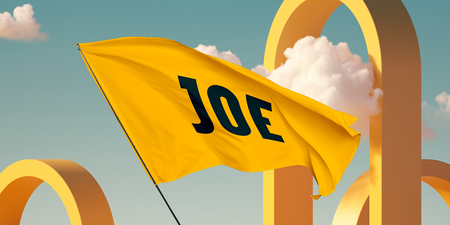“What the hell is going on here?”
It’s a Tuesday night. Kildare players are still recovering from the trip to Longford.
For 69 minutes at the weekend, they were being dragged around the Pearse Park trenches, trailing for the entirety of the game until an incredible show of character, and a more incredible showing from substitute Chris Healy, secured a last –gasp smash and grab. They’re still in the championship. For now.
Survive and advance: that’s all there is to it at this time of the Irish calendar and, in the evening of June 26, with just 16 teams remaining in the football championship, it really is the height of the summer in every sense.
But yesterday’s draw has pitted Kildare with the second best team in the country. Only two own goals denied Mayo an All-Ireland two years ago when they drew with Dublin in the final. Two one-point defeats since then separated them from Sam Maguire and now the task for Cian O’Neill is to somehow derail a team who haven’t failed to make it to the semi-finals since 2010.
This Tuesday night is a little bit different though.
The players are meeting for the first time since Saturday. They’re training in St. Conleth’s Park. In Newbridge. Where else?
Since the league campaign finished in April, the county grounds have become their training base but there’s a commotion tonight. Outside the gates, a herd of supporters meet each of the footballers as they arrive one by one. Roars go up. Some of them applaud. Five days out from the Mayo game and the place has already hit fever pitch. TV cameras have taken up position and they’re filming anyone moving in the direction of the stadium. Journalists are there. Phones are being held up as people scramble to take photos and videos. Amidst all the chaos, a banner is raised above the heads and the noise and it’s reading three simple words: Newbridge or nowhere.

To a group of young men only here to kick a bit of ball, they might not realise it now but this is the moment when everything changed. This is the line in the sand, the cause that the whole country will rally behind. This is breaking point, the precise time when the people will stand up once and for all and say, ‘no more’.
“This is surreal,” that’s all they’re thinking in the camp as they filter into the changing room, the air as buzzing as you’d expect, boys wondering what the fuck is happening outside. The players and management have planned a meeting before training to discuss their stance, the one that has brought the national spotlight to their doors.
The GAA have threatened Kildare; they’ve made it clear that the Round 3 game is going ahead at Croke Park and a no-show is as good as a forfeit. Kildare have said that they’re going to be in Newbridge on Saturday night. They were given home advantage in the draw and they will only play in their home venue. Newbridge or nowhere.
“We spoke about that,” Eoin Doyle, the captain of the Kildare panel, said that the players were happy to stick to their guns, even with the risk of being thrown out of the championship.
“We said it, ‘It might inevitably come to this, lads. We have to be aware of that.’ Because, listen, this was a players’ decision. It wasn’t the county board or the management – they backed us and they spearheaded it – but the decision was ours because, ultimately, if that was the case and we were thrown out, we were going to be the ones losing out on representing our county and we were the ones going to be losing out on the chance to fulfil our dreams that year.
“We were fully aware that could’ve been one of the possibilities. “Croke Park were determined that the game was 100 per cent going ahead in Croke Park and we couldn’t say we’re not playing there and then go and play there. That would’ve been completely taking a backward step and not fighting for what we felt we were entitled to.
“We went through our stance, ‘this is what we’re doing, this is what we’re prepared to do, and we’re not budging.’”
The meeting takes just 10 minutes.
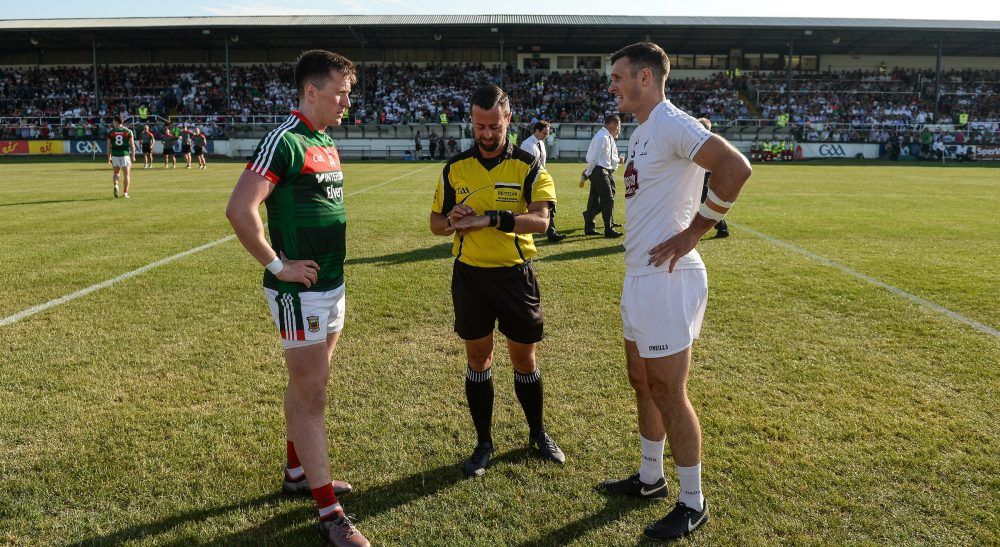
But an entire nation doesn’t just suddenly become mobilised in what felt like a call to arms over a nonsensical fixture decision. Every county has fallen victim to the GAA before but, this time, they came together. There was no reason for people in Antrim to feel aggrieved for Kildare. Clare folk had no business hitting out at the GAA’s militant stance that said the Lilywhites would simply have to play in Croke Park. And why else would Mayo natives – the bloody opposition who’d have to go to a hostile away ground for a must-win clash otherwise – stand up for Kildare’s right if this injustice wasn’t just the latest in a long line of events that showed the GAA had lost touch with its people?
You see, this time, when one county’s fair advantage, their chance to host one of the big guns at home in front of all their locals, and the GAA’s own rules were disregarded within hours in a move that would drive a bigger gate at Croke Park, it was the tipping point.
The commercialisation of the association, whilst not a bad thing, has led to bad things. It’s more tickets for sponsors and clients on All-Ireland day, less for the fans. It’s more games no longer available for the public to watch on terrestrial TV. It’s more and more decisions being made with profit as the motivating factor.
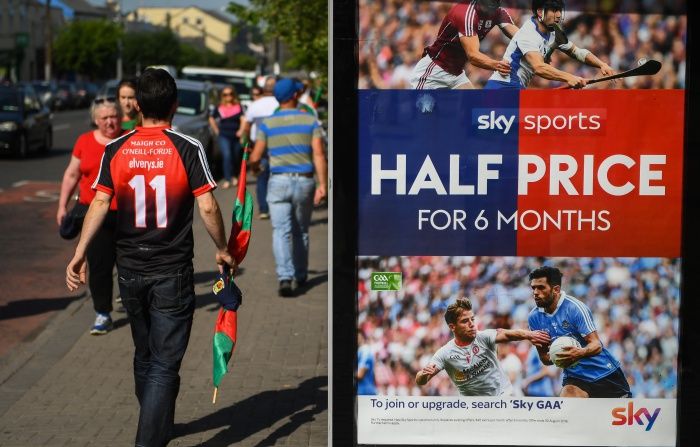
That’s why, when the country was still reeling from the introduction of the Sky deal in 2014 – a move that shook the core of everything this amateur organisation stands for, an association run by the people for the people – the GAA doubled down and signed up for another five-year package.
The figures watching on the British channel aren’t great but Sky are slowly and cleverly making their move. At the same time, they announced a five-year partnership with the GAA themselves, one that would see them invest €3m of their own back into grassroots initiatives.
Suddenly, Sky are infiltrating schools and camps with campaigns to get more kids participating in Gaelic Games and to give them more role models, players who they might never get to watch unless they’ve subscribed to Sky Sports. So some of the biggest names in the country are going straight to the youth with their Sky-branded t-shirts and the thing is becoming normalised for that generation.
The long game, you’d have to think, is to take total ownership of GAA coverage because, as it stands, Sky get nothing out of what they’re investing. However, if you own the sole rights to GAA games, you own the viewing base of Ireland. But you can’t do that without elbowing your way in and disguising yourself as part of the culture and fabric of society. That must be the play for Sky in the big picture – it must be – and the alarming thing is that it might actually be a play for the GAA too because that’s where the money’s at.
Meanwhile, the Club Players Association – formed out of necessity with one desire to ‘fix the fixtures’ – is banging its head against a wall as the GAA largely refuse to acknowledge its existence – the existence of a movement that has recruited over 20,000 players.
At Congress, the CPA’s motion for voter transparency is rejected emphatically. A proposal that GAA people should have the right to know what their county delegate has voted for is labelled an “insult” and 83 per cent move in unison to throw it out on its ear. For now, the private ballots remain even though those voting are only supposed to be carrying out the wishes of their county, as mandated democratically.

The Super 8s will introduce a round robin format at the quarter-final stage but, for some reason, comes with a few stipulations that you can no longer discuss or amend.
So, if you want this shiny, new tournament restructure, it comes with bringing the All-Ireland forward three weeks. That gives the clubs more time but no time in the summer when they can actually play and the fact that eight teams now have three games at the quarter-final stage means eight counties are affected in the prolonged and somehow condensed schedule. It’s a longer season, games-wise, but a shorter calendar.
There’s another quirk to the Super 8s that isn’t up for deliberating on. It’s slipped in beneath the restructure too – with the message, again, if you want a bit of change, you have to swallow the rest of it. Whilst six counties will play a home match, an away match, and a neutral match in the 2018 All-Ireland quarter-finals, Dublin will play two of their games at Croke Park. Two home games. That means someone will play two away games and, this year, it’s Donegal because they’ve drawn the Dubs as their ‘neutral’ Croker clash and they have to go away to Roscommon as well.
But this inevitable clusterfuck wasn’t even queried at Congress when the Super 8s passed.
No, instead, counties rowed in behind it, encouraging each other about the prospect of having big games in provincial venues whilst the rest of them were feeling emboldened and empowered and stood up to call on each other to seize the opportunity to show the masses that the GAA is capable of change.
Not one person asked why Dublin would have the natural advantage with this format even though Paraic Duffy accepted as much when he was pushed on it by Colm Parkinson on The GAA Hour back in 2016.
Duffy: Well, Dublin will play their home games in Croke Park, so that does give them an advantage.
Parkinson: That does give them an advantage. I’m surprised at that.
Duffy: To be fair to Dublin, that’s no different than it is at the moment. The one thing this would guarantee would Dublin is that they would head down the country. They’d be travelling down the country on a regular basis.
Parkinson: Why would Dublin’s neutral game be in Croke Park? Why not be fair about it? Move them to O’Moore Park, to Nowlan Park. Make them go out of Croke Park because that’s their home venue. If it’s supposed to be a home and away basis, why do Dublin get the advantage of having theirs’ in their home ground?
Duffy: It’s a point. It could be looked at.
It wasn’t looked at.
2018 is as ambitious a project as the GAA have ever undergone.
This is the year they try to keep everyone happy but, in the process, change nothing that actually needs changing. The purpose of adding 12 more games onto the football championship is the hope it will bring about more competitive fixtures but they give themselves three less weeks to do so as the third Sunday in September is consigned to history.
The national league calendar is condensed so April can be freed up and left exclusively for club players but clubs don’t really care too much about having county players available in April and country managers aren’t too keen on abandoning preparations just weeks before the championship starts.
Besides, the current model leaves absolutely no room for error. A weekend in April is already taken up with league finals and the All-Ireland quarter-finals need to start by July but even before the turn of the year, chaos hit. And all it took was bad weather.
Then bad weather in January meant pre-season competitions in every province were disrupted. Kerry and Tipperary had already decided that they weren’t bothered about the McGrath Cup and they’re better off too. A game in the FBD League in Connacht was just stricken off, unnecessary. And bad weather in February meant counties were having to fulfil fixtures on the only rest weekend offered throughout the league whilst the O’Byrne Cup, which started on the 30th December, played its semi-finals on the 14th January, ends with a whimper in a nothing game on May 13, six weeks after the national league ends and two weeks before Meath and Westmeath start their Leinster campaigns.
From the offset, the GAA are firefighting but every single decision they make in haste is directly impacting on real people – the same people they call the lifeblood.
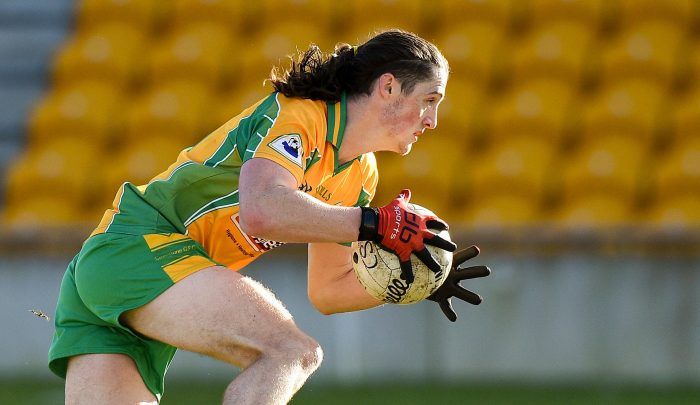
By 3.35pm on Saturday 17 February, Kieran Molloy has already missed five minutes of the Sigerson Cup final.
The rise of NUIG is the story of the prestigious colleges competition and the Galway wing back has been a staple of their success. Out of nowhere, they gatecrash their way into the decider for the first time in 15 years but, just three days later, Molloy has to choose: an All-Ireland final with his university or an All-Ireland club semi-final with his club.
Corofin have been through the bloody ringer in Tullamore. They slog out a win over a dogged Moorefield outfit, winning 1-6 to 0-6 in the end and doing it with 14 men after Martin Farragher, in little over a minute, was given one of the most despicable red cards you’ll ever see – even in this association. Molloy plays the whole game with his club but, as the final whistle blows and his team mates and family are marvelling in a third ever All-Ireland final spot for the Galway outfit, he has to go. And he has to go right now.
Five minutes before the end of the club game, NUIG got underway against UCD so Molloy leaves at 3.35pm from Offaly for a game that started at 3.30pm in north Dublin.
From O’Connor Park to Santry, he has nothing but a banana and a bottle of water for company.
“I didn’t know what the story was when I arrived up there. I didn’t know at all, I just wanted to get there to try and help them,” he said of his rush that got him to the Sigerson final with just under 25 minutes remaining.
“Whether they were 20 points up or 20 points down, I would’ve still liked to have been there. I just wanted to help.”

“Adrenaline kind of took over,” he said.“Maybe in the last play, my calf started cramping but the want to be there… I really wanted to play and I really didn’t want to let the lads down in that sense. I didn’t even think about whether I was tired or not.”In a one-point game that UCD eventually came out on top in, Molloy is still reeling over an effort that hit the post after he had surged down the right wing to deliver would-be heroics. Even on a day that saw his club advance to the All-Ireland final, one they’d go on to win, the pain of Sigerson defeat sits with him as well as the regret of missing 39 minutes of the action.
“You’d imagine that the GAA would be able to do a better bit of planning than that.
“I know it’s a rare situation but they’re two high profile games and it was the first year there was no Sigerson weekend so, with just one game, they could’ve put it forward or back.
“It can be very unfair on players. Even if it was pushed back a day… It was even putting the people out as well, not just the players. If people wanted to go to the two games, they couldn’t.
“People were coming up to me in the street that week saying, ‘best of luck, I’d love to be there but I’m going to the club game’. It was putting everyone out.”
The saving grace for the Project and Construction Management student is that he has two years left in NUIG and two more chances to win the Sigerson. The drawback of that, of course, is that it’s another two potential years of this kind of fiasco.
Molloy already missed out on the entire league campaign in his first year with the Galway senior team because he had the temerity to be successful and the grind to be committed. He probably missed out on a Sigerson Cup because of the same reason.
In an era when being a dual player at county level could almost be a museum display, and when playing hurling and football at all is still bordering on madness, the decisions filtering down from the top are making it increasingly impossible to compete in even one code for more than one team. And the same folk who won’t even entertain the question of professionalism don’t even realise that every time someone has to choose football over hurling, county over club, club over college, they’re pushing the entire organisation down that very route.
The worrying irony though is that the only thing that has saved the GAA in 2018 is the hurling and that divide between the two codes.
Whilst the football season stumbles from one mess to the next and the suits scramble to diffuse the most recent controversy, usually by a process of asking how comfortable they are with hitting a percentage of the victims in the collateral damage, hurling has enjoyed one of its finest ever championships. The provincial groups were a roaring success – constant, competitive games, upsets, stories and the two drawn semi-finals were just the delicious cherry on top. But it was a cake made up of just 10 counties really and that’s a future that should scare the living daylights out of football and, indeed, the GAA.
What happened though almost mirrored real-world politics.
As the hurling purists were high and the football lovers paranoid, it started a clash of snobbery against touchiness.
The success of the hurling and the decline of the competitive football championship turned the two parties against one another and the public became completely enshrined in this utterly pointless battle over who’s sport was better. A good game couldn’t even be enjoyed without someone looking in over the fence to try and rub it in on the neighbours. A bad game couldn’t be lived through without stats and comparisons and, just like the real problems of the real world, the unforgivable incompetence of those in leadership are often forgotten as the people turn on each other instead – as black argue with white, left against right, rich against poor – the GAA and their bumbling hiccups and scandalous hypocrisy were handed lifeline after lifeline and a chance to paper over each and every crack whilst their people were too busy going at each other.
By the time they’re refusing the Liam Miller memorial match entry to Pairc Ui Chaoimh, every one of their members isn’t at boiling point but they’re at least ready to put down their swords for a second and ask what the hell is going on.
Whatever about Liam Miller being a Gael and having an underage club career in the GAA, there are so many elements to this story that would turn your stomach, mostly the human element that an organisation was willing to ignore.
The GAA cited the rules as if there was nothing they could do, as if they weren’t their own bloody rules and as if anyone in the country would’ve given a toss if they had broken them for this case anyway.
They cited the rules because no foreign sport can be played on GAA grounds so there was just no way of indulging in sacrilege for a friendly between Manchester United and Irish legends to remember Liam Miller.
They cited the rules as if the rules aren’t nearly a century out of date. As if we’re in that place now. As if no-one in the GAA dabbles in any kind of ‘foreign sport’ activity.
And they cited the rules as if they don’t break them themselves when it suits. When opening Croke Park to massive rugby and international soccer games didn’t just make sense for a small country but it made a hell of a lot of sense for the GAA too.
It was just another silly, rash decision made out of old-fashioned ignorance and it was another decision that drew widespread criticism, disdain and shame.
It was another one that the GAA simply had no choice but to go back on – publicly pressured into doing the right thing – but it meant that, when Donegal soon came knocking on their doors to ask why should they have to play their neutral game in the Super 8s as an away match against Dublin in Croke Park, the GAA were never going to entertain a third retraction in the one summer.
At lunch time on Monday, Eoin Doyle’s phone won’t stop.
The Kildare captain is a primary school teacher so he’s at least free to answer but the calls and texts just keep coming. Despite being drawn at home against Mayo, the fixtures are released and they’re told they have to go to Croke Park on the Saturday – for their home game.
The rumours had been circulating in the morning and, sure enough, they were soon proved true.
“Straight away you knew that lads weren’t happy with it.
“Now, if there was a reason behind it – if the county board said it can’t be on in Newbridge for whatever reason – then you just have to accept these things and move on. But there was no reason like that so it aggravated lads even further.”
The fact that Kildare were going to play one of the best teams in the country in a knockout game was only a side issue but an important issue nonetheless. They needed every advantage they could get and the players wanted every advantage they could get – especially when it was given to them fair and square in the first place.
A message went into the WhatsApp group: ‘Lads, what do we want to do here? Do we want to fight for what
we’re entitled to?’
By 6 o’clock, their manager’s appearance on the RTE News showed what they wanted to do. The players were willing to go down and sacrifice their place in the All-Ireland football championship – in a year they’d go the whole way to the last eight – and to do it for justice. For what was right.
Cian O’Neill relayed that message to the whole country when he showed up on the TV screens all over Ireland and on the mobile phones on packed trains as people made their commutes home, entirely gripped by what was unfolding.
Despite the GAA’s tough assertion that Kildare would forfeit their place if they didn’t make it to Croke Park, O’Neill spoke with composure and conviction and explained in no uncertain terms where Kildare would be on Saturday night. It was only going to be Newbridge. Newbridge or nowhere.
“It definitely showed leadership,” Doyle said.
“It highlighted the stance that we were taking as players. Even though that was our manager there, the way we went about it meant it wasn’t as distracting as people might think. We were just focusing on the game and preparing ourselves for playing in Newbridge.”
The fact that they had the backing of the nation made it easier for the Kildare players but it wouldn’t have affected their decision in the first place. This was a fight for what was right and fair, a fight against what people were saying the GAA had become, a place where one county could be tossed aside like that in favour of profit.
On Monday night, Kildare had the people behind them. They had the right cause and they had the GAA’s own rules behind them too.
“You were hearing about it everywhere you went, it was on the radio and all over social media, everyone in the county was talking about it.
“But when we went to training on the Tuesday, it was put to bed by us. We were fully aware that we were playing the game in Newbridge. Although it hadn’t been officially announced, that’s where we were playing and that was that.”
That was that.
The final straw. The first coup.
You know, when the GAA was formed in 1884, it was formed as a game for the people. It became a very fundamental expression of Irishness, of who we were. It grew and it grew but it never lost touch with its roots. It prided itself on amateurism, on democracy on being an organisation and a game that was always run by the people for the people but, somewhere along the way, somehow, the people have been increasingly forgotten about.
In June of 2018, finally, someone took a stand. Kildare fought back.
No revolution, no new ideology, just a county refusing to be pushed around for no good reason. Just people reclaiming their game
Sometimes, you have to fight back
And perhaps, now, it’s time the people took back what was supposed to be theirs all along.
The FootballJOE quiz: Were you paying attention? – episode 10

